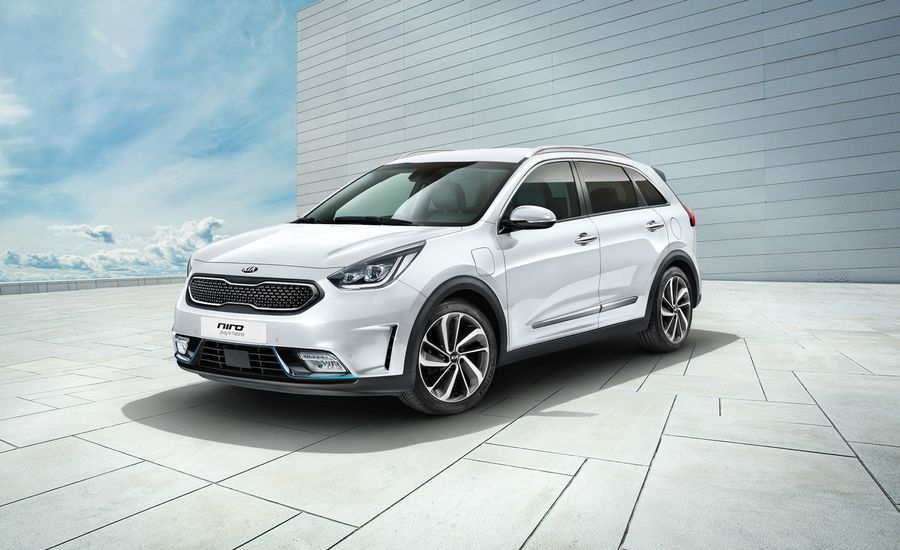KIA ADDS PLUG-IN HYBRID TO NIRO RANGE

-
With potential fuel economy of well over 200mpg and CO2 emissions of just 29g/km, the Niro PHEV is easily the Korean company's most efficient car to feature a combustion engine ever. It will be a cornerstone of Kia's drive to reduce the average CO2 emissions of its range by 25 per cent, based on 2014 figures, by 2020.
The PHEV is a stand-alone model in the Niro line-up, based on the mid-range (grade 3) Niro parallel hybrid (with ADAP). Standard features include the latest connectivity and active safety technologies, including Kia Connected Services featuring TomTom, wireless smartphone charging, autonomous emergency braking and lane-keep assist. It also offers Android Auto and Apple CarPlay which, via pre-downloaded apps, link smartphones to navigation, music, hands-free calls and texts and voice recognition services.
The Niro PHEV is also equipped with a 4.2-inch colour TFT supervision cluster, a reversing camera and front and rear parking sensors, roof rails, privacy glass on the rear windows and tailgate and LED tail lights and daytime running lights. It has special 16-inch alloy wheels with aerodynamic plastic covers, dual automatic air conditioning, an automatic windscreen de-fogging system, all-round electric windows and electrically adjustable folding door mirrors with LED indicators. A DAB radio, USB and AUX ports, a leather-covered steering wheel and gearshifter, black leather upholstery, chrome interior and exterior door handles, rain-sensing front wipers and an under-floor tray are also standard. The front seats and steering wheel are heated and there is eight-way power adjustment and powered lumbar adjustment on the driver's seat.
It is available in six colours, including optional Gravity Blue which is exclusive to the plug-in Niro. The standard paint colour is Rich Espresso, while other options are Clear White, Graphite, Midnight Black and White Pearl.
Plug-in hybrid powertrain promotes outstanding efficiency
The Niro PHEV features the same 1.6-litre direct-injection petrol engine as the parallel hybrid, but in the plug-in model this is paired with a more powerful 44.5kW (60bhp) electric motor. The Niro PHEV is capable of travelling up to 36 miles on the energy stored in its batteries, which means many owners will be able to complete their daily commute without using a drop of petrol or producing any tailpipe emissions.The petrol engine develops 104bhp and 147Nm of torque, and conforms to Kia's policy of adopting high-efficiency downsized power units for all new models. In the Niro range it marks the first combination of an Atkinson combustion cycle, cooled exhaust gas recirculation, direct petrol injection and a long-stroke specification for maximum efficiency. The Atkinson cycle holds the intake valve open longer than in a normal Otto cycle engine and also reduces the compression ratio to extract a greater proportion of energy from the combustion process rather than wasting it as heat. Efficiency is further aided by an exhaust heat recovery system which speeds the engine warm-up process.
The 44.5kW (60bhp) electric motor is powered by an 8.9kWh lithium-ion polymer battery pack rather than the 1.56kWh system in the parallel hybrid. Together, the two power units produce 139bhp, with 265Nm of torque available in first gear for rapid acceleration from standstill. The Niro PHEV can cover 0-60mph in 10.4 seconds and has a top speed of 107mph.
The greater energy storage capacity of the PHEV's batteries allows the car to travel up to 36 miles on electric power alone. As a result, its official CO2 emissions figure is just 29g/km, so business users pay only 9 per cent company car tax in 2017-18, while the certified fuel consumption figure is 217.3mpg. A brake energy recovery system recoups energy normally dissipated as heat and stores it in the batteries for use later.
Drive to the front wheels is through a six-speed dual-clutch automatic gearbox (6DCT) rather than the continuously variable transmission (CVT) used by most hybrids. This gives more direct and immediate response with greater refinement, and incorporates a Manual Sports mode to allow keener drivers to select gears manually.
A Transmission-Mounted Electric Device (TMED) allows the combined 139bhp of the two power units to be transferred to the drive wheels simultaneously, with minimal energy losses. This differs from the power-split system typical of CVT transmissions, which convert a portion of engine output for delivery through the electric motor, resulting in a loss of energy. TMED allows the hybrid system to access battery power directly at higher speeds for swifter response.





